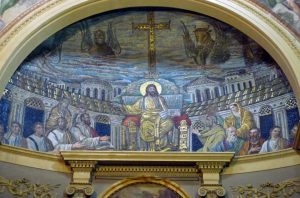29 7.2: Early Christian Art After Constantine – Imperial Christian Art
EARLY CHRISTIAN ART AFTER CONSTANTINE: IMPERIAL CHRISTIAN ART
Constantine became the sole emperor of the Roman empire after it had been divided (the Tetrarchy). He credited his victory over his rival Maxentius to the Christian God. Although Constantine did not become a Christian until his deathbed in 337 CE, he paid for numerous Christian churches and aided in its spread and adoption by powerful individuals. With imperial power behind it, Christian art and architecture took on a different character. Given its grander nature and association with the ruler of Rome, it is often referred to as Imperial Christian Art.

EARLY CHRISTIAN IMPERIAL ARCHITECTURE
Prior to the Edict of Milan Christian worship took place in houses that are referred to as house churches. This form of gathering is mentioned in several places in the New Testament and the house church at Dura Europos documents their existence. During the reign of Constantine, the need for Christians to have their own public places of worship came to the fore.
One of the first churches that Constantine sponsored was Old St. Peter’s in Rome (the building is underneath the current church). It became a model for Christian architecture for nearly a millennium. In selecting the style of architecture for the new Christian church, architects turned to a building type already in the Roman repertoire: the basilica.

The Early Christian Basilica TASK 1
The videos in this section examine the architectural features of the basilica and the appropriateness of it for a Christian house of worship. After watching the videos, please answer the accompanying questions.

Early Christian church architecture: the Basilica
Basilica of Santa Sabina, Rome
The Early Christian Basilica TASK 1 prompts:
What was the basilica in the Roman world?
Why was it an appropriate model for a Christian place of worship?
What are the main parts of the basilica plan?
What is the significance of the orientation of the new Christian church?
Which feature would be added by Christian architects and would give the building a cross-like appearance?
How would these have been decorated?
IMPERIAL MOSAICS
In ancient Greek and Roman art, mosaics were typically used as flooring. Tiny pieces of stone or tesserae were embedded in a filler. In the Early Christian period mosaics of stone and glass adorned the walls and apses of churches. Filled with scenes from the Old and New Testament and images of Christ, the Virgin Mary, and saints mosaics both provided a sumptuous backdrop for worship but also educated viewers on Christian teaching.

Santa Pudenziana TASK 1
Once Christianity became legal and grew in popularity, architecture was not the only thing to change. With more powerful patrons and a public setting, the character of the imagery changed. Before the Edict of Milan, artistic scenes were often merged in a piecemeal fashion to emphasize a particular theme, like salvation. As the repertoire of images grew, intricate programs were created. Along with a greater complexity and sophistication, the way Christ was represented also changed. After reading the short essay, please answer the accompanying questions.

Santa Pudenziana article (read for for TASK).
Santa Pudenziana TASK 1 prompts:
What was the physical focal point of the church?
How does the image of Christ resemble the emperor?
How is the idea of triumph emphasized?
Compare and contrast the image of Christ at Santa Pudenziana and the St. Domatilla Catacomb?
How did art fundamentally change after Constantine?
Galla Placidia TASK 1
The city of Ravenna in Italy has more Early Christian and Byzantine mosaics than anywhere in the world. The video explores one of the monuments there and discusses the importance of the city.

The Mausoleum of Galla Placidia, Ravenna
Galla Placidia TASK 1 prompts:
Describe the importance of Ravenna at the end of the Roman empire in the West?
Why was Galla Placidia so significant?
What was the function of the building?
Which aspects are still Roman in origin?
Which characteristics are naturalistic, and which are not?
Further reading: “Constantine’s stamp on early Christian art,” by Roderick Conway Morris, New York Times.
https://www.nytimes.com/2005/07/02/arts/constantines-stamp-on-early-christian-art.html

